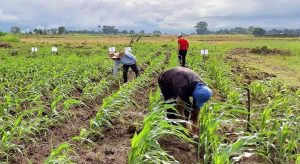THE Department of Agriculture (DA) said its output growth target for this year is achievable if no major typhoons hit the country in the remainder of the year.
The DA had set a 2024 growth goal of between 1% to 2%, accounting for the effects of the El Niño and La Niña weather events.
“With the La Niña, as long as there are no big typhoons, I think we should be able to increase production,” Agriculture Secretary Francisco P. Tiu Laurel, Jr. said in a post-SONA discussion on Tuesday.
In his address to Congress, President Ferdinand R. Marcos, Jr. said that the government continues to focus on farm production through the provision of seed, fertilizer, livestock, boats, and technical and financial assistance.
Mr. Laurel said that the agricultural production target was “not easy” to achieve because of the El Niño and the expected La Niña during the latter part of the year.
“We started El Niño last January then it ended in June, and now we’re coming into La Niña,” he added.
The government weather service, known as PAGASA (Philippine Atmospheric, Geophysical and Astronomical Services Administration), estimates a 70% likelihood of La Niña occurring between August and October.
Last month, PAGASA announced the end of El Niño after the conditions in the tropical Pacific returned to El Niño Southern Oscillation neutral levels, meaning neither El Niño nor La Niña currently is in effect.
He added that production could also be bolstered by the increase of irrigated land following the expansion of coverage by the National Irrigation Administration.
Due to the dry spell caused by El Niño, agricultural production during the first quarter was little changed by 0.05%, according to the Philippine Statistics Authority (PSA).
The PSA is set to release its first half and second quarter agricultural output data on Aug. 7.
The DA estimated agricultural damage due to El Niño at P9.89 billion.
Agriculture accounts for about a tenth of Philippine economic output.
Mr. Laurel downplayed the US Department of Agriculture (USDA) rice import estimate of 4.7 million metric tons (MMT), saying he does not expect imports to go that high.
In a recent report, the USDA increased its forecast for Philippine rice imports at 4.7 MMT for the year, upgrading its earlier estimate of 4.6 MMT.
The USDA said that it had hiked its forecast after first-half imports came in higher than expected.
In the first half, rice imports came in at 2.33 MMT, 25.3% higher than the 1.86 MMT recorded a year earlier, according to the Bureau of Plant Industry.
“I don’t think the lowering of tariffs will really increase imports…The only reason it will increase imports is because of demand, not because of lower tariffs,” he added.
Executive Order No. 62, signed by Mr. Marcos, lowered the tariff on imported rice to 15% from 35% until 2028. The order is aimed at reducing prices of the staple to help tame inflation. — Adrian H. Halili
